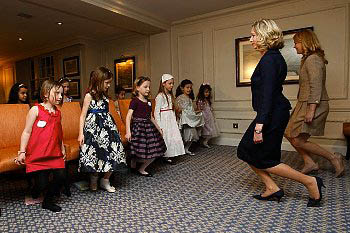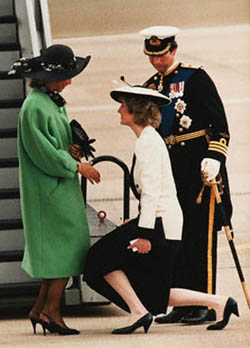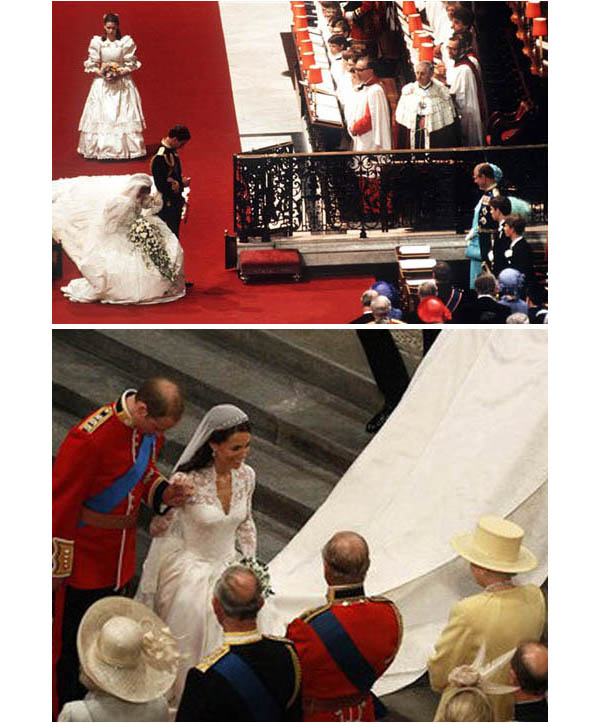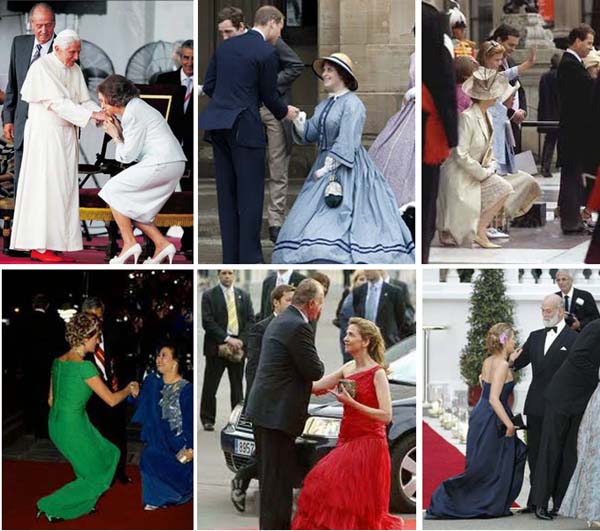 |
Manners, Customs, Clothing
The Resurgence of the Curtsy
Judith Fife Mead
With the marriage of Catherine Middleton to Prince William, there has been a new spark of interest in the curtsy. In England it is still the custom for women to curtsy in front of royalty. So some young American girls who are enthused with Princess Kate – or princesses in general – are enrolling in “curtsy classes” to learn this traditional gesture of greeting, the lady’s equivalent of the man’s bow in Western culture.

Girls learning to curtsy at a 'Princess boot camp' |
It is unlikely the American girls will actually have the opportunity to greet a queen or princess, but it is interesting to see that they would like to be prepared to exercise the proper form of obeisance, should that occasion arise.
A friend recently called me to ask if I thought girls should learn to curtsy. And if so, when would be the suitable occasion to do it. It seemed an opportune occasion to discuss the charming gesture and to offer a balanced proposal for the return of the custom. I don’t believe little girls should be bobbing up and down in clumsy curtsies all the time. But to know how to make a correct curtsy and execute it on the appropriate occasions is, in my opinion, a very good and fitting thing for a young girl and woman to know.
When I was a girl and a student of the Ursulines in New Orleans, it was common practice for the girls to curtsy each time we met one of the nuns in the hallway. Placing the right foot a little behind the left foot, we would slightly bend both knees and at the same time greet her, “Good morning Mother Teresita,” or “Good afternoon, Sister Cecilia.” It was not a genuflection (where the right knee touches the floor), which was reserved for Our Lord Jesus Christ in the Tabernacle. It was, however, a very beautiful gesture demonstrating the extra respect we were taught to show for these religious who had consecrated their lives to Christ.
Unfortunately, in the 1960s, this custom was discontinued. I spoke to several of my old teachers, but none of them could remember why the curtsy was put aside. It seems to me that it was just part of the modern and egalitarian changes that were sweeping through the Church and secular society at that time.

Court debutantes curtsy; the English Debutante Ball was abolished in 1958 |
For example, when I went to my 1922 Emily Post book, in Chapter 35 titled “The Kindergarten of Etiquette,” it is advised that in good homes boys are always taught to bow to visitors and girls to curtsy. These gestures, Mrs. Post tells us, are ways to show respect for one’s elders and for children to become used to instinctive good manners.
By the time we reach the late 20th century, however, the now reigning Miss Manners by Judith Martin, issues a decree that Americans should never curtsy, especially to royalty, because “the curtsy is the traditional gesture of an inferior to a superior.” We Americans, she continues, who fought a war of independence to be free of noble titles and customs, should simply shake the hand of royalty or anyone else. (Miss Manners’ Guide to Excruciatingly Correct Behavior, pp.693-694).
I disagree most vehemently with this decree of Miss Manners. Every well-ordered Catholic society is hierarchical, as Dr. Marian Horvat and I point out in our book Courtesy Calls Again. Signs of deference and respect are the good fruit of the customs developed in a Christian Civilization, and we should do all in our power to promote or revive them whenever we can.
How to curtsy
The word "curtsy," or "curtsey," derives from the word "courtesy." It is in fact a form of showing courtesy to one who is above you in rank or station. In the past it was used consistently in daily life, not just reserved for royalty. One need only watch a Jane Austin film to realize how women and girls used to curtsy regularly for those of senior social rank, just as men and boys bowed.
The simple curtsy is very easy to learn and make. The whole act takes a few seconds and is done in one graceful motion. These are the steps:
- Bend your head slightly.
- Hold your skirt out sideways with your thumbs and first two fingers with the little fingers extended, or hold your hands straight on each side.
- Extend your left leg slightly behind your right one, with the toe touching the floor. At the same time bend your right leg slightly, keeping the back straight and still holding the head in a nod. Bend your knees outward, rather than forward. Then gracefully bring yourself back to your original position.

Princess Diane curtsies before Queen Sofia of Spain |
When paying obeisance to royalty, the deep curtsy – or full court curtsy – is made. It is more elaborate and difficult to master and very elegant to view when properly executed. A full court curtsy is much lower than the ordinary one. Again, the left foot is slightly behind the right foot and resting on the toe. Then, with both knees outward, one sinks gradually towards the ground – as far as your nimbleness permits - bending the head slightly forward. The greater part of the weight is on the right foot when bending down, and is transferred to the left foot on rising.
This curtsy requires careful practice to be made with the back straight, only the head slightly bent and without any jerks on the way down or up.
The court curtsy is still made at debutante balls in the United States and in some European courts. In the United Kingdom Queen Elizabeth and her family are often greeted by curtsying ladies. Members of the Royal Family always bow and curtsy to the Queen when they meet her for the first time in the day. The King and Queen of Spain also seem to receive bows and curtsies on a very regular basis, and their children also often greet Their Majesties with a bow or curtsy. The late Princess Diane was well known for her deep and very elegant curtsy.
When to curtsy
It seems to me the curtsy is always appropriate at the end of awards presentations or music recitals. After receiving an award at a formal ceremony, the girl should curtsy to the teacher or principal to show her gratitude. The performer curtsies to her teacher or the maestro, also a sign of gratitude.

At left, a graceful curtsy at the end of a performance; at right, the head should be slightly bent forward, not to the side |
At the end of an instrumental or chorus performance, it is still customary today for the men to bow and the ladies to curtsy, although some directors, following the egalitarian tendencies of our times, let the girls bow as well. A young lady in a skirt should always curtsy instead of bowing.
If a family is having a formal dinner or afternoon tea in their home, it is appropriate for their daughters to make the short curtsy before the special guests when they are formally introduced.
In traditional Catholic schools, where the nuns still wear the full habit, it would be nice to see the custom of curtsying when greeting a Sister reintroduced.
The girl who crowns the Virgin Mary at a May crowning or presents flowers to her in a ceremony should certainly curtsy before the statue of the Queen of Heaven as a befitting sign of the deferential respect due to her.
These are a few suggestions. To close, I invite my readers to watch Princess Catherine making her obeisance to the Queen on her wedding day here. A simple late 19th century bow and curtsy are executed here. You may also find many lovely pictures of the curtsy being executed by or before members of the European Royalty here.

Top, the famous curtsy of Diana of Wales before the Queen on her wedding day;
bottom, an analogous gesture of Princess Catherine
|

Top left, Queen Sofia of Spain greets the Pope farewell at the Barajas Airport, Madrid; center, Prince William receives the homage of an actress in costume at Prince Edward Island, Canada; right, Sophie, Countess of Wessex, at the 100th birthday ceremony of the Queen Mother; bottom left, Princess Diana greeting Queen Sirikit of Thailand; center, Infanta Cristina and her father King Juan Carlos of Spain; right; Princess Tatiana of Greece pays homage to Prince Michael of Kent
|

Posted December 5, 2011

Related Topics of Interest
 The Debutante Ball in Laredo The Debutante Ball in Laredo
 Style Reflects Moral Profiles of People and Epochs Style Reflects Moral Profiles of People and Epochs
 The Importance of the Greeting The Importance of the Greeting
 St. Isidore of Seville on Dignified Manners St. Isidore of Seville on Dignified Manners
 Courtesy in the Catholic Home Courtesy in the Catholic Home
 No to Rodeo Girls, Yes to Escaramuza No to Rodeo Girls, Yes to Escaramuza
 Dressing Well: Vanity or Virtue? Dressing Well: Vanity or Virtue?
 Do Not Embrace the Queen Do Not Embrace the Queen
 Refinement and Sanctity Refinement and Sanctity

Related Works of Interest
|
|
Manners | Cultural |
Home | Books | CDs
| Search | Contact Us
| Donate

© 2002- Tradition in Action, Inc. All Rights Reserved
|
 |

|